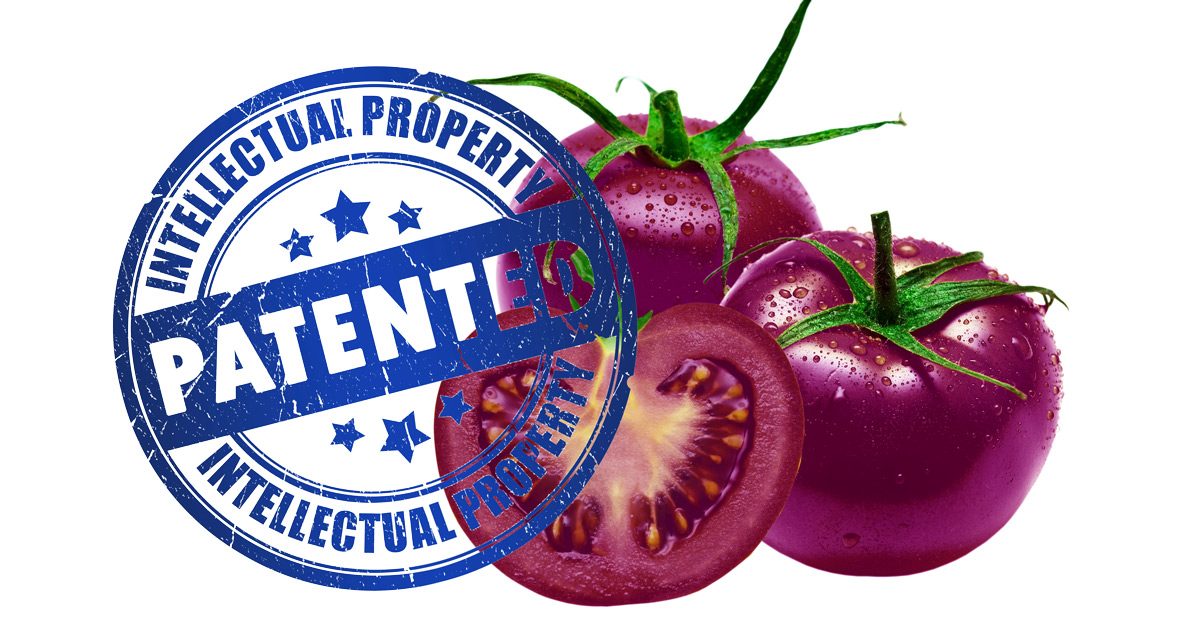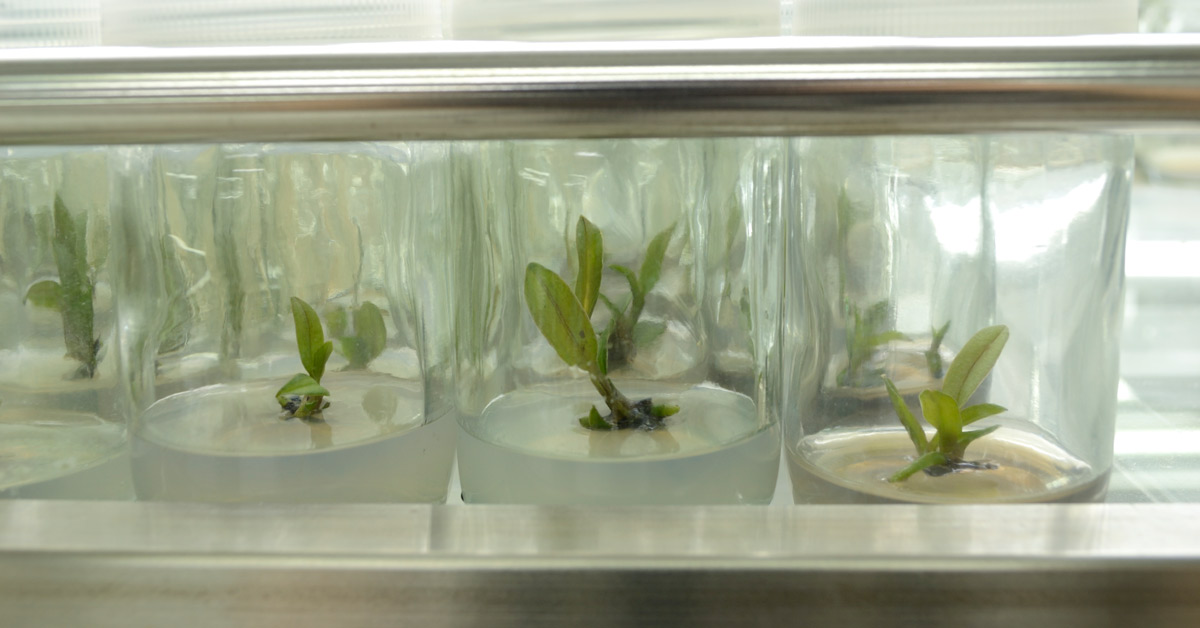As some EU and UK politicians race to remove regulatory safeguards from new GMOs, news continues to come in about the failure of first-generation GMOs (see GM WHEAT AND BARLEY) and the trade problems they give rise to (see CONTAMINATION and MEXICO'S GMO RESTRICTIONS ARE JUSTIFIED). It is particularly ironic that at a time when governments and regulators around the world are being pressured to streamline their GMO regulations, with the US as the explicit or implicit model to follow, the US regulatory system is being exposed as a complete sham, designed to promote GM food acceptance rather than ensure safety (see MEXICO'S GMO RESTRICTIONS ARE JUSTIFIED).
Meanwhile the GM purple tomato developed in the UK has gone on sale to home gardeners in the US, prompting the reappearance of unsubstantiated claims of health benefits (see GM TOMATO) and a new patent dispute with a non-GMO seed company - see PATENTS ON SEEDS for details and for several other important items on how patents are instilling fear into seed breeders (see also SEED FREEDOM). And look out for a diverse array of other GMO content covering such things as GENETIC DETERMINISM, NON-GMO ALTERNATIVES, GMO MICROORGANISMS, and more.
GM WHEAT AND BARLEY
No to GM wheat!
On 26 January 2024, a food sovereignty alliance from Latin America, Africa, and Asia approached seven UN Special Rapporteurs for their urgent intervention to block the cultivation and trade of GM wheat HB4. This follows the approval in Argentina, Brazil, and Paraguay of the commercial production of this GM wheat variety and the approval in South Africa, Colombia, Nigeria, New Zealand, and Indonesia of the importation of the GM wheat, suggesting a widespread failure in biosafety governance across the globe. The groups are urging the governments of Argentina, Brazil, and Paraguay to suspend or revoke all authorisations for the commercial growing of GM HB4 wheat. They recommend that the government of Paraguay revokes Resolution No. 556/2023 – through which transgenic HB4 wheat was approved – and reforms the GMO regulatory framework, by way of an open, transparent participatory process, with emphasis on the need to protect the rights of Indigenous people and peasant communities. They also recommend that the government of Argentina bans the cultivation of GM wheat in the country.
Organisations around the world warn of GM wheat risks and low yields
The Argentine newspaper Página 12 has published a report by the investigative journalist Dario Aranda on the call, endorsed by over 100 food sovereignty movements in the Global South, for the United Nations’ intervention over GM wheat. In their detailed document, the social movements, peasants, and Indigenous peoples point out the lack of independent studies affirming the safety of the GM HB4 wheat commercialised by the Bioceres company (nicknamed “the Argentine Monsanto”). They also denounce the dangerous herbicide glufosinate ammonium (long banned in the European Union), which HB4 wheat is engineered to tolerate. They also flag up that in addition to the absence of safety testing, official Argentine government data shows that the GM wheat is less productive than conventional wheat.
GM wheat, barley field trials proposed in Australia
Field trials of GM wheat and barley are proposed in South Australia, in a project of the University of Adelaide.
GM TOMATO
As GM purple tomato goes on sale to home gardeners in US, dubious cancer claims reappear
Recently NPR ran a story reporting that the GM purple tomato, genetically engineered with genes from snapdragons to contain high levels of the antioxidant anthocyanin, is now on sale to home gardeners in the US.
But there are lingering doubts about whether it's safe to eat – and that even applies to the intended change of high antioxidant levels, let alone the GM process-induced unintended changes.
And dubious claims about the tomato’s supposed “cancer-fighting” ability have resurfaced, in spite of the fact that they were debunked back in 2008 by the UK's National Health Service and Cancer Research UK, among others.
Revealingly, the NPR article, after indulging in the obligatory pro-GMO hype, describes conventionally bred anthocyanin-rich purple tomatoes that have been available for years. Jim Myers, the plant breeder responsible for the Indigo family of purple tomatoes, says there are now more than 50 cultivars of the Indigos being grown and bred throughout the world. “There’s just all this diversity in the Indigo market class that has come about through conventional breeding,” he says. “With the GMO tomato, it's taken them all this time and more to get one variety out there.”
There's some history about the GM purple tomato here. This GMO has already become mired in a patent dispute (see PATENTS ON SEEDS, below).
GM BANANA
GM banana claimed to be resistant to Panama disease given approval for Australian consumption
A GM banana claimed to be resistant to Panama disease has been given approval for consumption in Australia. The GM banana has been developed as an industry back-up in case Panama TR4 disease breaks out, but will not replace the Cavendish variety. Scientists used a gene from a wild banana that is almost immune to the disease and placed it in a Cavendish variety. The GM banana was developed by Prof James Dale, leader of the banana biotechnology program at the Queensland University of Technology. GMWatch comments that this GM banana is unlikely to have robust disease resistance.
FSANZ fails responsibility for duty of care as untested GM bananas get go-ahead
Food Standards Australia New Zealand (FSANZ) has not required evidence of the safety of the GM bananas it approved for consumption (see above) and there has been no testing in feeding trials, writes GE-free NZ. The approval is in tandem with the Office of the Gene Regulator (Australia) allowing planting of the bananas if there is an outbreak of the fungus that causes the soil borne Panama Disease. The plants won't be grown or eaten immediately, but are being rubber-stamped for future rollout. Approvals of GM bananas is of great concern to the local banana industry developing in New Zealand, where there is no soil borne Panama disease. Growers in other countries with diverse varieties do not have the vulnerability that monoculture has created for the Australian industry. Bananas are a first baby food and lack of safety would have serious implication for infants.
CONTAMINATION
EU flags unauthorised GM ingredients in Chinese rice noodles, sparks food safety debate
In a recent development that has stirred concerns over food safety and regulatory compliance, the EU’s Rapid Alert System for Food and Feed (RASFF) flagged a batch of Chinese rice noodles for containing unauthorised GM ingredients. The RASFF report detailed the detection of unauthorised GM ingredients in the rice noodles, prompting immediate action by Dutch authorities. The product, which had not yet been placed on the market, is now subject to either redistribution or destruction. Since 2006, GMO rice has been regularly found in the EU despite there being supposedly almost zero commercial cultivation of GMO rice anywhere in the world — apart from a small amount in the Philippines in the last year.
MEXICO'S GMO RESTRICTIONS ARE JUSTIFIED
Mexico’s precaution on GM corn safety is justified
A Presidential decree has banned the use of GM corn for food in Mexico. But the governments of the US and Canada are using the US-Canada-Mexico trade agreement (USMCA) to challenge Mexico’s actions. The purpose of Mexico’s restrictions on GM corn is to safeguard the integrity of native corn from GM contamination and to protect human health. The purpose of the US and Canadian challenge is to defend the interests of the biotechnology industry. The US and Canada want to force Mexico to open its market to all GM foods and seeds. Canada is supporting the US challenge (as a third party in the dispute) even though Canada does not export any corn to Mexico. Mexico has the right to restrict the use of GM corn. The US argues that Mexico’s actions are not based on scientific principles, but the government has sufficient science to justify its precautionary policies, writes Lucy Sharratt of CBAN.
Mexico defends GMO corn restrictions with science
In its 200-page response to the US in the USMCA trade dispute (see item above), Mexico has shown it has the latest independent science firmly on its side. The risks from direct consumption of GMO corn are laid out by Mexico, with 13 pages of evidence and 66 academic references from peer-reviewed journals. And the risks from consuming glyphosate residues on GMO corn are laid out by Mexico, with 16 pages of evidence, including 74 academic references.
Mexico points out that lax US regulatory processes fail to ensure safety. It says the US’s USMCA submission, far from proving that Mexico’s measures are not based on science, presents information that lacks scientific rigour, that is dangerously outdated, or that is marked by clear conflicts of interest, such as funding by the biotech industry. The US also selectively cites broad surveys by science agencies, such as that of the US National Academy of Science in a 2016 report. Researchers for the American Academy of Pediatrics commented on the report: “There were no long-term, published epidemiologic studies directly assessing the potential health impact of genetically engineered food and associated herbicide exposure, so conclusions about health were largely made in the absence of available data.”
In addition, Mexico notes:
• US regulatory standards are weak since they do not require animal feeding studies or other safety assessments before a new GM variety is approved.
• The often-cited “4,000+ studies that show GM safety” are rife with these errors. Most come from companies’ own tests when they sought approval from US regulators to commercialise new GM varieties. Few are peer-reviewed. Fewer are based on long-term animal feeding trials.
• Mexico highlights that the US cannot produce a single academic study that shows that the long-term consumption of large quantities of minimally processed GM corn treated with glyphosate is safe to eat. That is why Mexico took the precautionary measures it did.
• Mexico also presents extensive evidence of the risks to native corn varieties from cross-pollination by GMO corn. Such contamination can undermine native corn’s genetic integrity, which is a unique and endangered natural resource valuable not just to Mexico but also to the world.
High levels of genetically engineered toxins and glyphosate in GMO corn pose serious health risks in Mexico
Friends of the Earth (FOE) US has released a briefing backing Mexico's ban on GM corn for human consumption, which FOE recently submitted to the USMCA dispute settlement panel charged with considering the US government's challenge to the ban.
“The US government’s submission to the tribunal is seriously deficient. It lacks basic information about the toxins expressed in contemporary GMO corn varieties and their levels. The US submission also ignores dozens of studies linking the insecticidal toxins and glyphosate residues found in GMO corn to adverse impacts on public health,” according to Dr Kendra Klein, deputy director of science for Friends of the Earth and co-author of the FOE comments.
“The US government has not presented an ‘appropriate’ risk assessment to the tribunal as called for in the USMCA dispute because such an assessment has never been done in the US or anywhere in the world,” said coauthor Dr Charles Benbrook.
The comments show that since the commercial introduction of GMO corn varieties in the 1990s, there has been an approximate four-fold increase in the number of toxins and pesticides used on the average hectare of GMO corn. Subsequently, the levels of genetically engineered insecticidal toxins found in GMO corn grain are 50-100 parts per million (ppm), up from 2-6 ppm – the average when the limited existing GMO corn food safety studies were carried out up to 30 years ago. These levels exceed maximum food tolerances for widely used corn insecticides by 40- to 2,000-fold. The consequences of simultaneous exposures to multiple genetically engineered toxins, along with residues of glyphosate and other pesticides used in growing corn, have not been evaluated – a massive scientific gap in the ability to accurately assess human health risks of GMO corn as it could be utilised in Mexico.
The US’s sham GMO regulatory system cannot ensure safety
The Center for Food Safety (CFS) has released its analysis supporting Mexico in its bid to maintain restrictions protecting its food supply from potentially hazardous GMO corn. CFS maintains that Mexico cannot be forced to rely on US protestations that GM foods are safe, because the US position is based on a sham regulatory system designed to promote GM food acceptance domestically and abroad rather than ensure GMOs are safe. What passes for GMO oversight fails the definition of “regulation” in USMCA, says CFS, since it is not mandatory and is filled with loopholes and inconsistencies, rather than applying generally to all GMOs.
“GMO regulation in the US was crafted by Monsanto, now owned by Bayer, and is a critical part of our government's promotion of the biotechnology industry,” said Bill Freese, science director of CFS and expert on biotech regulation. “The aim is to quell concerns and promote acceptance of GMOs, domestically and abroad, rather than critically evaluate potential toxicity or allergenicity.”
USMCA corn case submissions
The Institute for Agriculture & Trade Policy (IATP) has published a convenient collection of submissions to the UCMCA panel at the link above.
Mexico's GM corn restrictions: Hardline US stance ignores non-GM corn opportunity for US farmers
United States commodity organisations have cheered on the US government as it tries to get Mexico’s restrictions on GM corn declared in violation of the US trade agreement with Mexico and Canada, arguing that it cuts farmers’ export markets and sales revenues. But what if Mexico’s modest restrictions could instead turn out to benefit US farmers who shift to premium non-GM corn markets as international corn prices fall? It sounds counter-intuitive, but it might just be true, writes Ken Roseboro.
Mexico considers adding GMO corn ban to the constitution
Mexico's president has proposed modifying the constitution to ban GMOs and safeguard maize as a pillar of the country's identity and food sovereignty. The environment minister has also emphasised the risks associated with GMO crops and the use of harmful glyphosate. Unsurprisingly, Big Ag is not happy about the proposal to declare Mexico a GMO-free country.
SEED FREEDOM
Argentine president wants to outlaw seed saving
Argentine president Milei’s bill calling for Argentina to join UPOV91 (the International Union for the Protection of New Varieties of Plants) was defeated in Parliament. Now he wants to stop farmers from freely saving seeds via another method – local regulations or a new seed law – reports La Nación. There’s more about UPOV91 here.
PATENTS ON SEEDS
GM purple tomato company targets non-GMO seed company over alleged patent infringement
The company that is commercialising the GM purple so-called “anti-cancer” tomato has targeted a non-GMO heirloom seed company over alleged patent infringement. In its 2024 catalogue, Baker Creek Heirloom Seed Company in the US offered a “non-GMO purple tomato”, the Purple Galaxy. Baker Creek said it was then contacted by Norfolk Healthy Produce, the US subsidiary of Norfolk Plant Sciences. Norfolk Healthy Produce, in Baker Creek’s words, “expressed concern that the Purple Galaxy might have been derived from its patented genetically engineered tomato”. Baker Creek withdrew the Purple Galaxy seeds, saying, “Subsequent laboratory testing conducted in conjunction with Norfolk did not conclusively establish a relationship between the Purple Galaxy and Norfolk’s GM purple tomato. Indeed, such contamination should be unlikely in Europe, given its approach to GM crops. But the testing also did not conclusively establish that the Purple Galaxy is truly free of any genetically modified material.” The episode reveals much about the current climate in which plant breeders and seed retailers are increasingly living in fear of legal threats from GMO developer companies.
Prophetic but misleading: Fictitious examples in patents
Many patents in the field of life sciences contain fictitious examples, known as “prophetic”, of how the invention can be realised, reports an article for Inf’OGM. Such imaginary examples enable applicants to increase the scope of their patents. This is a common practice that is now taking on significant proportions. The rapid development and strong competitiveness of this sector encourages its players to file numerous patent applications as soon as possible. This is the case even if, when the patent application is filed, the invention is not sufficiently supported by real examples. This is why applicants resort to “prophetic” examples. In the US, since the early 1980s, the USPTO (US Patent and Trademark Office) has accepted such examples if they are not misleading and have a reasonable scientific basis. The USPTO also requires that they be distinguished from actual examples in the text of the patent. The EPO (European Patent Office) also allows prophetic examples, provided they are reproducible. But a 2021 survey shows that 75% of European patent applicants do not distinguish prophetic examples from real ones in their patent applications.
GMWatch comments that this article is very important, coming at a time when GMO developers and their allies are trying to get patented new GMOs deregulated in the EU, potentially leading to an influx of patented seeds, on the basis of unfulfilled promises of future products.
We’re losing our seed breeders
Public seed breeders, often academics who work to help farmers and gardeners, are rapidly disappearing. All the while, commercial breeders with patented, expensive seeds are consolidating. Farmers want their crops to succeed, and seeds that go through the breeding process can become more resilient to weather or pests. But the lack of diversity in commercial seed options and the dwindling number of public breeders leave farmers with fewer choices — and they’re paying more. Seed prices rose 700% over the last two decades for GM seeds, and around 200% from non-GM seeds. Farmers aren’t the only group with fewer options here. Because private sector breeding often results in patents, public breeders are unable to experiment with most seeds a private breeder produces — leaving some wary.
“The privatisation of actual genetic traits is really troubling,” said Chris Smith, executive director of the Utopian Project, a nonprofit that focuses on crop diversity in the food and farm system. “I should be allowed to work with purple carrot genetics without worrying about being sued. And that’s not our current reality, which is really scary to me.”
"Laying claim to nature’s work": Plant patents sow fear among small growers
For nearly 40 years, Frank Morton has been breeding plants. He began breeding specialty salad greens, once a rarity in the produce market. Using an organic farm system, Morton developed novel lettuce varieties. Though he loves the work, being a small-scale plant breeder doesn’t come without challenges. Over the years, Morton has watched large corporations take over the seed industry, using utility patents to claim seeds as an invention. A utility patent protects an invention from being used, replicated or sold without permission. This has left smaller-scale breeders in limbo, often unsure of what they can and can’t use when developing new plant varieties.
Morton has experienced first-hand the effects of such patents. In 2021, he shared one of his lettuce varieties, the frilly-leaved “Funny Cut Mix”, with a trusted customer who also breeds plants. The customer planned to include “Funny Cut Mix” in their lettuce trials, which plant breeders use to evaluate how well a variety will perform. A few months later, the customer informed Morton that his “Funny Cut Mix” would be excluded from further trials because it looked like a patented lettuce type called Salanova, owned by the Dutch company Rijk Zwaan. Though he didn’t use any patented material to develop “Funny Cut Mix”, Morton’s variety was excluded simply because its appearance might infringe on that patent.
Morton doesn’t blame his customer. Instead, he points to the restrictive system of utility patents and the fear it instills in small-scale seed breeders. GMWatch comments that this is an important article that must be read by anyone concerned with the future of our food and farming. GMOs are an easy way to patent plant varieties, though bad practice at patent offices means that non-GMO varieties are also increasingly patented.
LAWSUIT TO STOP GMOs IN INDIA
GMOs will destroy Indian agriculture, which is non-GMO, and will harm the health of 1 billion Indians and their animals
Hybrid Bt cotton, the only commercialised GM crop in India, has failed conclusively, writes Aruna Rodrigues, lead petitioner in the public interest lawsuit in the Supreme Court of India for a moratorium on GMOs since 2005. Based on this failure and the evidence on GM crops to date, the Union of India’s proposal to commercialise GM herbicide-tolerant (HT) mustard will destroy not just Indian mustard agriculture but citizens’ health. There were five days of intense hearings on this matter in the Supreme Court, ending in January 2024, following the GMO Public Interest Writ that Aruna filed almost 20 years ago in 2005.
She writes, "In these last 20 years, piecemeal hearings have dealt with submissions relating to individual crops like hybrid Bt cotton, the attempted commercialisation of hybrid Bt brinjal (2010) and now the attempt to commercialise hybrid HT mustard. The evidence provided here is a distillation of the critical inputs of those 60+ submissions based on the affidavits and studies of leading, independent scientists and experts of international renown."
GENETIC DETERMINISM
It’s time to admit that genes are not the blueprint for life
The view of biology (and especially genetics) often presented to the public is oversimplified and out of date and scientists must set the record straight, argues a new book by science writer Philip Ball titled How Life Works. In a review of the book, Denis Noble, emeritus professor of physiology and biology at the University of Oxford, writes, "Genetics alone cannot help us to understand and treat many of the diseases that cause the biggest health-care burdens, such as schizophrenia, cardiovascular diseases and cancer. These conditions are physiological at their core, the author points out — despite having genetic components, they are nonetheless caused by cellular processes going awry. Those holistic processes are what we must understand, if we are to find cures... Scientists must take care not to substitute an old set of dogmas with a new one. It’s time to stop pretending that, give or take a few bits and pieces, we know how life works."
GMO MICROORGANISMS
Potential harmful effects of genetically engineered microorganisms on the intestinal microbiome and public health
GMO microorganisms' horizontal gene exchanges might induce multiple human diseases and current regulations do not protect public health, according to scientists who have published a new peer-reviewed paper. They recommend that “Widespread use of natural and genetically engineered intestinal biotics should be halted, and public labelling and clear transparency should be instituted.” The scientists conclude, “It is important to remember that prevention is the most cost-effective strategy and primum non nocere [‘first do no harm’, the first principle of medical ethics] should be the focus.”
EFSA launches consultation on new developments in biotechnology applied to microorganisms
EFSA’s Nutrition and Food Innovation Unit has launched a public consultation on the draft scientific opinion on new developments in biotechnology applied to microorganisms. Interested parties are invited to submit their comments by the 8 April deadline. Pro-GMO lobbyists are trying to have these experimental GMO microorganisms deregulated.
A few microorganisms modified by CRISPR are on the market
Eleven bacteria, 22 yeasts, one endophytic fungus (living symbiotically inside plants), and one micro-alga are either in the pre-commercialisation phase or, in the case of a minority, already on the EU market. These 35 micro-organisms identified by the European Food Safety Authority (EFSA) have been genetically modified with new GM techniques. The main tool used is CRISPR/Cas, in 33 out of 35 cases.
HUMAN GM
“No persuasive justification for pursuing heritable human genome editing” – international experts
An international coalition of scholars, advocates, and social change organisations has released its “Social Justice and Human Rights Principles for Global Deliberations on Heritable Human Genome Editing”. This document is the first to explicitly centre social justice principles and human rights in the high-stakes deliberations on the potential use of heritable human genome editing – that is, altering the DNA of embryos or gametes to result in genetically modified children. The document concludes that in light of the principles, “it is clear that there is no persuasive justification for pursuing heritable human genome editing”.
NON-GMO ALTERNATIVES
Soy cultivation in Europe is poised to break new ground
Soy cultivation in Europe is anticipated to soar between 5-10% in 2024, reaching an unprecedented 5.3-5.7 million tons. Key soy-producing nations within the EU and in Ukraine and Russia are expected to witness an expansion in soy growing areas.
Red nets signal “stop” to insect pests, reduce need for insecticides
Red nets are better at keeping away a common agricultural insect pest than typical black or white nets, according to a new study. Researchers experimented with the effect of red, white, black and combination-coloured nets on deterring onion thrips from eating Kujo leeks, also called Welsh onions. In both lab and field tests, red nets were significantly better at deterring the insect than other colours. Also, in field tests, onion crops which were either partially or fully covered by red netting required 25-50% less insecticide than was needed for a totally uncovered field.
Bugs protect apples when flowers planted on farms
Bugs including hoverflies, lacewings, and ladybirds play an important role in keeping Britain’s apples healthy, a new study has shown. Wildflower strips planted around apple orchards provide a habitat for predatory insects that prey on pests that deform and damage apples. Flower margins had been established next to five dessert apple orchards in the UK. A research team led by the University of Reading found that only 48% of trees had fruit damage compared to 80% in orchards without flowers.
NEW ZEALAND REGULATORY DECISION
New Zealand GMO watchdog decision risks compromising protection of farmers, environment and health
New Zealand’s Environmental Protection Authority (EPA) has released its decision on “null segregants”, defining them as “not genetically engineered organisms”. This followed the NZ government research institute Plant & Food applying to the EPA to determine if “null segregants” were classed as genetically engineered (GE) organisms. GE Free New Zealand is among those who are unhappy about this decision. Null segregants are GM plants that have been cross-bred to the point where the novel genetically engineered constructs, such as a foreign gene from another species (a transgene), have been “removed but the offspring still express the desired trait change”. In GMWatch’s view – one that is supported by the science underpinning genetic modification as well as, legally speaking, by the Cartagena Protocol on Biosafety – null segregants are new combinations of genetic material and may present new or increased risks. Therefore they need to be regulated and the trigger for that regulation should be the use of GM techniques in their development.
..................................................................
We hope you’ve enjoyed this newsletter, which is made possible by readers’ donations. Please support our work with a one-off or regular donation. Thank you!




